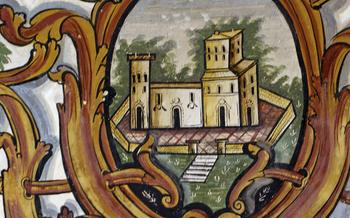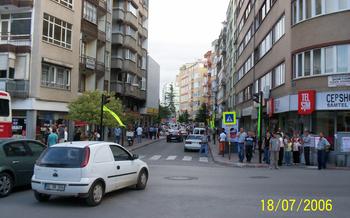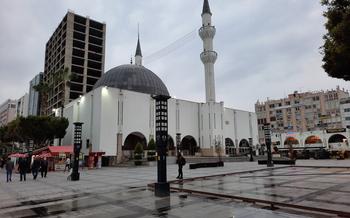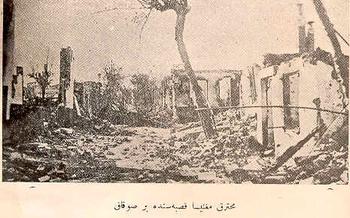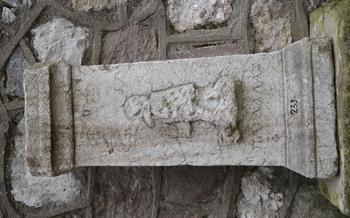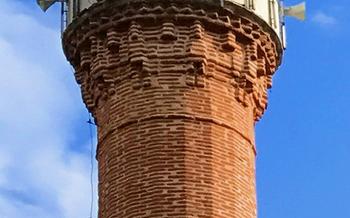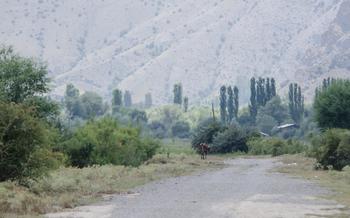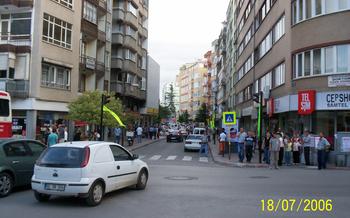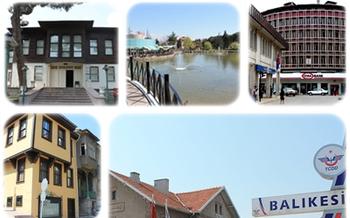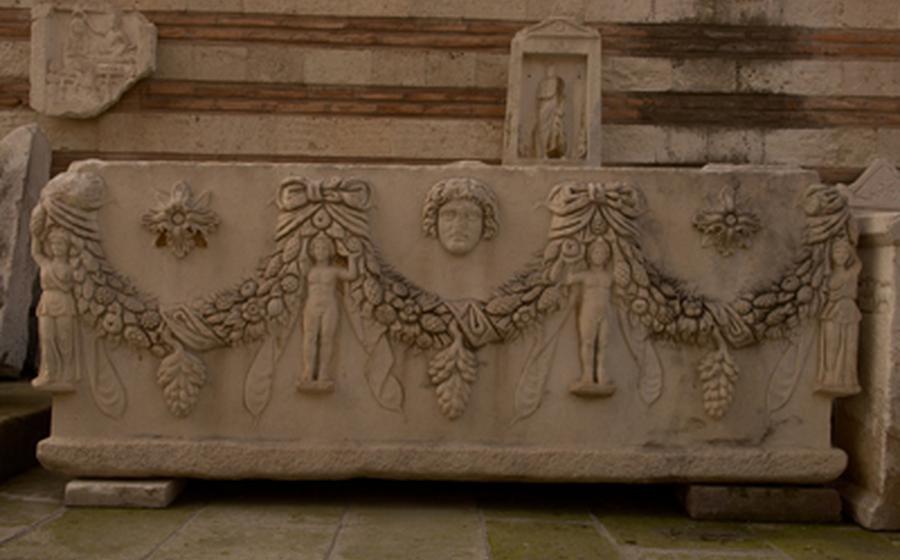
Manisa Laleli Mosque
- The Manisa Laleli Mosque: A Historical and Architectural Gem
- Location and Accessibility
- History of the Mosque
- Architectural Highlights: A Masterpiece of Ottoman Design
- Religious Significance
- Cultural Importance
- Visitor Experience
- Spiritual Atmosphere
- Surrounding Area
- Local Festivals and Events
- Tips for Planning a Visit
- Photography and Social Media
- Guidelines for Respectful Photography
- Sharing Experiences Online
- Educational Programs
- Insider Tip: Explore the Hidden Courtyard
The Manisa Laleli Mosque: A Historical and Architectural Gem
The Manisa Laleli Mosque stands as a testament to the rich history and architectural prowess of the Ottoman Empire. Constructed in 1574 during the reign of Sultan Murad III, this magnificent mosque holds a prominent position in the heart of Manisa, a city steeped in cultural heritage. The mosque's name, Laleli, translates to "Tulip," a symbol of beauty and elegance that finds its reflection in the mosque's intricate details and harmonious design. As a cultural landmark of great significance, the Manisa Laleli Mosque attracts visitors from around the world who come to admire its architectural splendor and experience the spiritual essence that permeates its sacred spaces.
Location and Accessibility
The Manisa Laleli Mosque is situated in the heart of Manisa, on Atatürk Caddesi. This central location makes it easily accessible by foot or public transportation. The mosque is well-connected to the city's bus network, with several bus stops within a short walking distance. If driving, ample parking is available in the surrounding streets.
For those arriving by train, the Manisa Train Station is just a 10-minute walk from the mosque. The proximity to other popular attractions, such as the Manisa Museum and the Manisa Castle, makes it convenient to combine a visit to the mosque with a broader exploration of the city's historical and cultural heritage.
The mosque's strategic location and ease of access make it an ideal destination for travelers seeking spiritual enlightenment, cultural immersion, or simply a chance to admire the beauty of Ottoman architecture.
History of the Mosque
In the year 1585, under the reign of the illustrious Ottoman Sultan Murad III, the construction of the Manisa Laleli Mosque commenced. This magnificent edifice stands as a testament to the sultan's devotion to his faith and his desire to leave an enduring legacy. The mosque's name, Laleli, pays homage to the abundance of tulips that once adorned the surrounding gardens, adding a vibrant touch to the mosque's already captivating presence.
Over the centuries, the mosque has borne witness to numerous historical events and played a pivotal role in the lives of countless individuals. It has stood resilient against the test of time, undergoing several renovations and restorations to maintain its grandeur. These efforts have ensured that the mosque's architectural integrity and spiritual significance remain intact, allowing it to continue serving as a beacon of faith and a symbol of Manisa's rich cultural heritage.
Architectural Highlights: A Masterpiece of Ottoman Design
The Manisa Laleli Mosque stands as a testament to the architectural prowess of the Ottoman Empire. Its exterior is a symphony of domes and minarets, each element contributing to its majestic presence. The dome, a defining feature of Ottoman architecture, dominates the skyline, symbolizing the heavens and the connection between the earthly and the divine. The minarets, slender and graceful, rise towards the sky, acting as celestial beacons and serving a functional purpose as platforms for the call to prayer.
Beyond its exterior grandeur, the mosque's interior is a treasure trove of intricate decorations and Iznik tiles. The walls are adorned with calligraphic inscriptions, verses from the Quran, and geometric patterns, creating a visually stunning and spiritually uplifting ambiance. The Iznik tiles, renowned for their vibrant colors and intricate designs, depict floral motifs, landscapes, and geometric patterns, transforming the mosque into a veritable art gallery.
The Manisa Laleli Mosque showcases several design elements that are characteristic of Ottoman architecture. The pointed arches, an iconic feature, create a sense of height and grandeur. The muqarnas, an ornamental element consisting of small niches or cells arranged in a honeycomb-like pattern, add depth and texture to the interior. The pendentives, triangular elements that support the dome, are adorned with intricate carvings, demonstrating the meticulous craftsmanship of the Ottoman builders.
In comparing the Manisa Laleli Mosque with other significant mosques in Turkey, it holds its own in terms of architectural grandeur and historical significance. While the Blue Mosque in Istanbul is renowned for its striking blue tiles and the Hagia Sophia for its awe-inspiring dome, the Manisa Laleli Mosque stands out with its unique blend of architectural features, Iznik tiles, and spiritual ambiance.
Religious Significance
The Manisa Laleli Mosque holds immense religious significance as a sacred place of worship for Muslims. Its primary function is to serve as a gathering place for the local Muslim community to perform their daily prayers and engage in religious rituals. The mosque is a symbol of faith, devotion, and spirituality, embodying the Islamic principles and traditions that shape the lives of its worshippers.
During prayer times, the mosque comes alive with the melodious recitation of the Quran and the fervent supplications of the faithful. The imam leads the congregation in prayers, guiding them through the sacred verses and rituals. The atmosphere within the mosque is one of reverence and tranquility, as worshippers seek solace, guidance, and connection with the divine.
Beyond its role as a place of worship, the Manisa Laleli Mosque also serves as a center for religious education and learning. Classes and workshops are often held to impart knowledge about Islamic theology, history, and practices. Visitors can engage with local scholars and experts to gain a deeper understanding of Islam and its rich traditions. This educational aspect of the mosque promotes interfaith dialogue, fosters understanding, and encourages respect for religious diversity.
Cultural Importance
The Manisa Laleli Mosque stands as a testament to the rich Islamic culture and heritage that permeates the city of Manisa. Its very existence serves as a symbol of the city's identity and pride, deeply embedded in the hearts of its residents. As a cultural landmark, the mosque contributes to the vibrant tapestry of Manisa's cultural landscape. Moreover, it serves as a reminder of the enduring legacy of traditional craftsmanship and artistic techniques that have been passed down through generations.
Visitor Experience
The Manisa Laleli Mosque welcomes visitors from all over the world, offering a unique and enriching experience. Accessibility for tourists is a priority, with wheelchair ramps and elevators ensuring that everyone can explore the mosque's wonders. Knowledgeable guides are available to lead tours in multiple languages, providing insights into the mosque's history, architecture, and religious significance.
For those who prefer a self-guided tour, audio guides are available in various languages, offering a personalized and informative experience. Visitors are encouraged to take their time, capturing the mosque's beauty through photographs. However, it is essential to be respectful and mindful of the mosque's sacred nature, adhering to the dress code and maintaining silence while inside.
Prayer facilities and ablution areas are available for Muslim visitors who wish to perform their religious duties. The mosque's serene atmosphere invites moments of contemplation and spiritual connection, fostering a sense of peace and tranquility. Whether you are a devout Muslim, a history buff, or simply an admirer of stunning architecture, the Manisa Laleli Mosque offers an unforgettable experience.
Spiritual Atmosphere
Stepping inside the Manisa Laleli Mosque, visitors are enveloped in a profound sense of tranquility and serenity. The mosque's spacious interior, adorned with intricate Iznik tiles and soft lighting, creates an atmosphere conducive to spiritual reflection and connection with the divine. The air is filled with the gentle murmur of prayers and the rhythmic recitation of verses from the Quran.
Devotees gather in the main prayer hall, their hearts and minds focused on their connection with Allah. The mosque's acoustics are such that the imam's voice resonates beautifully, carrying his words to every corner of the room. The faithful bow, prostrate, and rise in unison, their movements synchronized in a display of unity and devotion.
For those seeking a deeper spiritual experience, the mosque offers opportunities to participate in prayer and religious rituals. Visitors can join the congregation for the five daily prayers or attend special events such as the Night of Power (Lailatul Qadr) or the Feast of Sacrifice (Eid al-Adha).
Whether you are a practicing Muslim or simply seeking a place of peace and contemplation, the Manisa Laleli Mosque offers a unique and deeply spiritual experience. It is a place where visitors can connect with their faith, find solace, and experience the profound beauty of Islamic spirituality.
Surrounding Area
The Manisa Laleli Mosque is situated in the heart of the city, making it a convenient starting point for exploring Manisa's many other attractions. Take a leisurely stroll through the vibrant local markets, where you can haggle for traditional Turkish handicrafts, savor the aromas of freshly baked pide bread, and indulge in the sweet delights of Turkish lokum.
For a taste of history and culture, visit the nearby Manisa Museum, which houses a fascinating collection of artifacts that tell the story of the city's rich past. Learn about the ancient civilizations that once thrived here, admire intricate Islamic calligraphy, and marvel at stunning examples of Ottoman architecture.
After a day of exploration, relax and rejuvenate in one of the many charming cafes or restaurants that dot the area surrounding the mosque. Sip on a refreshing cup of Turkish coffee, savor the flavors of traditional Turkish cuisine, and soak in the vibrant atmosphere of this bustling city.
If time permits, consider extending your stay in Manisa to discover its hidden gems and experience the warmth and hospitality of its people. Explore the scenic countryside, embark on a nature hike, or visit the nearby ancient ruins of Sardis, once a prosperous city of the Lydian Empire. Manisa offers a harmonious blend of history, culture, and natural beauty, ensuring a truly unforgettable travel experience.
Local Festivals and Events
The Manisa Laleli Mosque is not just a place of worship but also a vibrant center of cultural and community events. Throughout the year, the mosque hosts various religious festivals and celebrations that attract both locals and visitors. One of the most significant events is the annual Mevlid-i Nebi, which commemorates the birth of Prophet Muhammad. During this time, the mosque is adorned with colorful decorations, and special prayers and recitations are held.
In addition to religious festivals, the surrounding area of the mosque often hosts cultural events and performances. These events showcase the rich cultural heritage of Manisa, including traditional Turkish music, dance, and art exhibitions. Visitors can immerse themselves in the vibrant atmosphere, mingle with locals, and experience the true essence of Turkish culture.
Participating in these local festivals and events is an excellent way to gain a deeper understanding of Turkish Islamic traditions and customs. Embrace the opportunity to witness the fervor and devotion of the local Muslim community and share in the joy and celebrations that bring the community together.
Tips for Planning a Visit
When planning a visit to the Manisa Laleli Mosque, it is advisable to consider the following guidelines:
For the best lighting and atmosphere, it is recommended to visit the mosque during the morning or late afternoon hours when the sun's rays illuminate the intricate details of the architecture.
Visitors should dress respectfully, adhering to local customs. Women are advised to cover their heads with a headscarf or shawl, while men should avoid wearing shorts or tank tops.
Upon entering the mosque, it is customary to remove one's shoes and place them on the designated shelves. Maintaining a respectful demeanor and avoiding loud conversations is essential to preserving the serene atmosphere of the mosque.
Prayer facilities and ablution areas are available for Muslim visitors who wish to perform religious rituals. It is important to respect the sanctity of these spaces and follow the established protocols.
Photography and Social Media
Capturing the Beauty of the Manisa Laleli Mosque
The Manisa Laleli Mosque is a captivating subject for photography enthusiasts. With its stunning architecture, intricate details, and serene atmosphere, it presents ample opportunities to capture its beauty through the lens. However, visitors should always prioritize respect and decorum while taking photographs within the mosque.
Guidelines for Respectful Photography
-
Obtain Permission: Before photographing within the mosque, seek permission from the mosque's authorities or designated personnel.
-
Avoid Disruption: Be mindful of ongoing religious activities and avoid using flash photography or creating disturbances that may disrupt worshippers.
-
Respectful Attire: Dress appropriately when visiting the mosque, and ensure that your attire is modest and respectful of the religious significance of the site.
-
Composition and Angles: Choose angles and compositions that highlight the mosque's architectural features without compromising the privacy of individuals.
Sharing Experiences Online
-
Social Media Engagement: Share your experiences and photographs on social media platforms to showcase the beauty of the Manisa Laleli Mosque to a wider audience.
-
Hashtags and Geotagging: Use relevant hashtags and geotags to connect with other travelers and enthusiasts interested in Islamic architecture and cultural heritage.
-
Captions and Storytelling: Accompany your photographs with informative captions that provide historical context, personal anecdotes, or reflections on the mosque's significance.
By following these guidelines, visitors can capture and share the beauty of the Manisa Laleli Mosque while respecting its sacred nature and contributing to the preservation of its cultural heritage through digital storytelling.
Educational Programs
The Manisa Laleli Mosque also serves as a valuable educational resource for those interested in deepening their understanding of Islamic culture and architecture. Educational programs and workshops are occasionally organized within the mosque complex, providing visitors with the opportunity to engage with local scholars and experts. These programs cover a wide range of topics related to the mosque's history, architectural significance, and the broader context of Islamic art and architecture.
Through these educational initiatives, visitors can gain insights into the rich cultural heritage and traditions associated with the mosque. They can explore the symbolism and meaning behind the mosque's design elements, learn about the techniques and craftsmanship involved in its construction, and trace the evolution of Islamic architecture over time.
These programs not only promote understanding and appreciation for religious traditions but also foster cross-cultural dialogue and create a space for meaningful conversations about the shared human experiences that transcend religious boundaries.
Insider Tip: Explore the Hidden Courtyard
Venture beyond the main prayer hall and discover a hidden gem within the Manisa Laleli Mosque complex – the tranquil courtyard garden. Nestled amidst the mosque's majestic architecture, this serene space offers a respite from the bustling city. Stroll along the cobblestone paths, surrounded by lush greenery and fragrant flowers. Take a moment to sit on one of the benches and soak in the tranquility, allowing the peacefulness to rejuvenate your mind and spirit. Don't miss the opportunity to capture the beauty of this hidden sanctuary through photography, as the play of light and shadow creates a picturesque scene.
